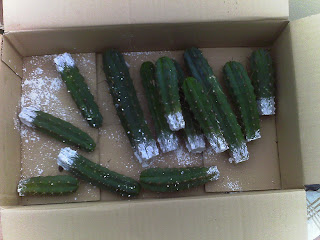This is an instructional page for growing goumet mushrooms using the Bag 'o' Mush kit available from us.
The kit comprises of.
*Injectable, sterilized, rye substrate bag,
*Bag of casing mix,
*Humidity tent with perlite,
*Alcohol wipe,
*Full instructions.
(we had to stop including the Golden oyster mushroom culture syringe, as we wanted to keep the cost of the kit down to a minimum. Gourmet edible live cultures are available from us though.)
All the information in the world wont help you if you dont keep youe gourmet mushroom growing project CLEAN!
Wipe surfaces, use anti-bacterial soap, wear surgical gloves even a mask. Take every precaution you can to keep contaminants away!
Why waste all this time and effort if you are going to cut corners on the preparation?
#1. Wipe the injection site with the alcohol wipe provided.
(The wiping action is almost as important as the alcohol on the wipe.
Remember clean is good!
#2. Inject the silicone injection site on the bag.
(Try not to puncture the needle right through to the other side of the bag!)
Incubate at 25-30C in the dark or with ambient light.
(the airing cupboard is often a good place, or build a tub in tub incubator.)
#3. The mycelium grows on the grain.
After a week gently break up the grain through the bag.
This will speed up colonisation.
Colonisation should take 25-30 days, assuming the temperature is right.
#4. When the grain is completely white
(colonised) its time to case. Add about
300ml of very hot water to to the bag
of casing mix and leave it to cool.
Casing is added to the top of the bag to keep moisture levels up and help prevent contaminants getting in. The casing layer also provides good conditions for baby mushrooms (primordea) to develop in.
Wrap the cased bag in tin foil and put it back to incubate (25-30C) for a further 3-5 days.
During the days since you put the foil wrapped bag back in to incubate, the mycelium will have started to grow through the casing layer, although this may not be immediately obvious.
#5. Fruiting. Roll down the remaining sides of the grain bag, leaving the tin foil on.
Dampen the perlite in the large humidity bag with about 350ml of cold tap water.
(this will provide humidity in the bag). Place the now open grain bag into the humidity bag on top of the wet perlite. Close the top of the humidity bag with a bulldog clip or clothes peg.
Place the bags in a warm, light place (20-24C), but not in direct sunlight. Open the bag and mist occasionally with clean water.
After 1-2 weeks you should start to notice the formation of pinheads (baby mushrooms).
Bag in fruiting conditions Pinheads developing
#6. The mushrooms usually take about a week to develop and can then be removed with a gentle twist and lift. You can expect several flushes (crops) of mushrooms per grow, with about a week in between them. After harvesting a flush, mist well for a few days to replace lost moisture. Good luck and enjoy!
PAGE STILL UNDER CONSTRUCTION. PLEASE CHECK BACK SOON!
























































